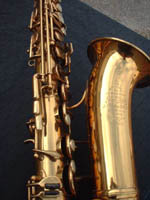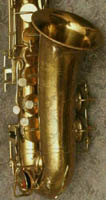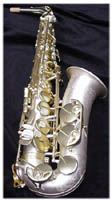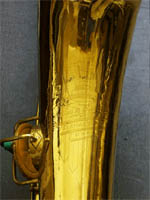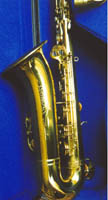First,
let me say that I've played a Mark VI alto (Bb and A), Bb soprano, two
tenors and a bari (Bb). I've also played a Super Balanced alto, Mark
VII tenor and an assortment of Super 80 altos and tenors. On the low
end, I've owned two different model Bundy (German [a Keilworth manufactured
horn] and USA) baris, a couple of Bundy II altos and played a Selmer
USA bari (you could say it's a "Bundy III") extensively before I bought
my YBS-52. I guess that gives me some experience with these horns. No,
I'm not prejudiced for this company -- their American Bundy line is
FAR surpassed by the Yamahas (but the Selmer USA's play awfully well
in tune). I can live without the Signets (their 300 line). But, still
...
The
Selmer saxophones are the crown jewl of saxophone manufacture. Most
histories of the sax include 1954 -- the date the Mark VI was first
manufactured -- as a milestone.
There
is a somewhat complete history of these horns HERE,
but I just wanted to note some things:
The
best horn I've ever played was a mid-60's low Bb Mark VI baritone. It
had a dark and resonant tone that I could only get close to in playing
a gold-plate (low Bb) Buescher aristocrat bari in a small practice room.
The
keywork on the Selmer horns, from the Balanced Action up to today (Super
80 Series III), is the most economical of any horn and works superbly,
and this is probably the reason why Selmer hasn't changed it much in
60 years. I somewhat prefer the action of the Buffet Dynaction for the
alto and soprano (light and springy), but the tenor and baritone saxophones
benefit from the tighter keywork on the Selmer horns.
Anyhow,
depending on your preference, the modern choice of the best saxophone
is a Yamaha 875 Custom or a Super 80 Series III. I prefer the Yamahas
... and they're cheaper (buy an 875 alto and get a 23 tenor, too, for
the price of an S80 tenor!)
Finally,
the Mark VI design is the most copied in the world. Look at an Amati,
Vito, Yani, Keilworth, Yamaha (model 52 and up), or Selmer themselves
(the Super 80 is nothing more than a not-quite-good-enough Mark VI).
If
you want to impress me, find me a gold-plate, low A Balanced Action
or the same in a Mark VI baritone sax. I'd buy that from you in a heartbeat.
Their
website is HERE.
Go HERE for a more-or-less
complete listing of all Selmer models in each type of plating. Go HERE
for an exposition about the various Selmer model types.




